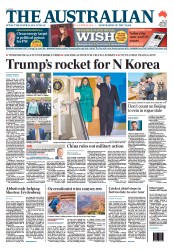The Australian
Jul 7 2017
This article in The Australian is noteworthy because it appeared on the front cover!
Andrew Snelling, a Christian who has a PhD in geology from the University of Sydney, told The Australian he had been trying since 2013 to get a permit to collect rock samples for a peerreviewed, scientific research project within the Grand Canyon that would challenge the idea that the rock layers are millions of years old.
Dr Snelling lodged his lawsuit against park administrators with the US District Court in Arizona just days after US President Donald Trump signed an executive order promising protection of religious freedoms “from undue interference by the federal government”.
“The Grand Canyon is the gold standard for geologists,” Dr Snelling said.
“It’s important because it’s the largest and deepest canyon in the world. It’s accessible, not surrounded by jungle. The walls are stacked like pancakes: shale, sandstone, limestone, mud. There are more rock layers exposed there than anywhere else.”
While most geologists believe that the Grand Canyon supports the theory that the earth is millions of years old, Dr Snelling believes that evidence for the Bible story of creation may be found in those stacked layers. In 2013, he applied to collect 40 to 60 samples, each fist-sized, for a research project. “They turned me down because they didn’t like the question I was asking,” he said.
In emails obtained under Freedom of Information legislation, park officials criticised his Grand Canyon project as “inappropriate” and “outlandish”. One said it was “dead end creationist”.
Dr Snelling is employed by Answers in Genesis, a US-based Christian think tank established by fellow Australian Ken Ham, who has built a replica ark in Kentucky.
“What I’m saying, as a geologist, is that there are folds in those rocks, so were they still soft when they were laid down?” Dr Snelling said. “Because if it looks like it was still soft when it was formed, that implies there was a short period of time between the layering, not millions of years.”
When his application for a research permit was dismissed, he put in a Freedom of Information request. “The way they referred to me, and my beliefs, it was defamatory,” he said. “My methodology was sound, but I was a Christian who had alternative views.”
Dr Snelling said he had withdrawn his lawsuit, after administrators agreed to grant the permit. Under the rules, the data he collects must be made available to other scientists.
“That’s fair enough,” he said. “I will provide the data to the park, to the public, and publish the results in scientific journals. Even if I don’t find the evidence I think I will find, it wouldn’t assault my core beliefs. We already have evidence that is consistent with a great flood that swept the world.

